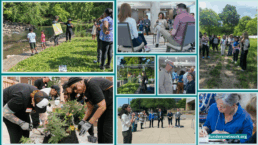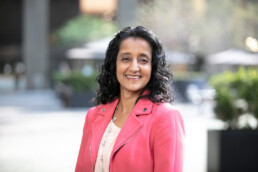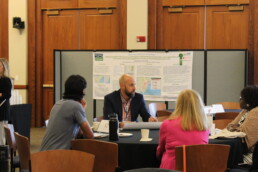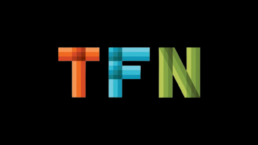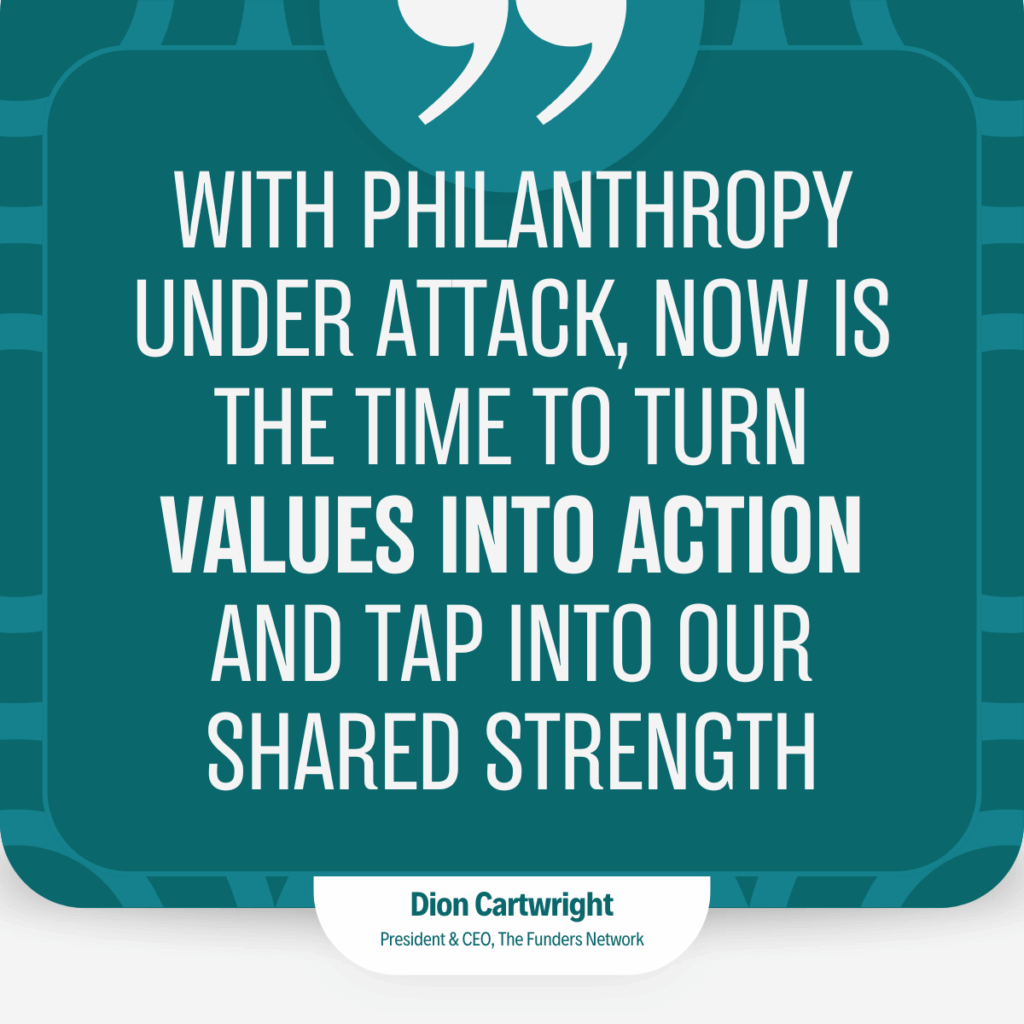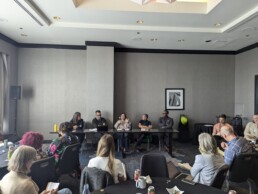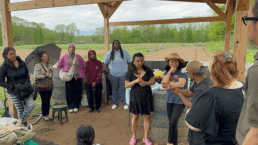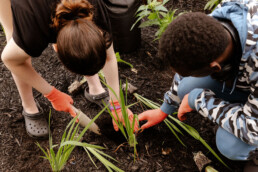Urban Water Funder Updates: Dr. Robert Bullard, Chris Tomlinson and Radhika Fox join our Houston lineup
BY TFN Staff
TFN's Urban Water Funders 2026 Annual Meeting will bring together funders from across the country for an intimate, engaging and interactive convening designed to spark new ideas, build stronger partnerships and explore collaborations that meet the needs of the moment.
Water issues have a profound impact on civic life, public health, climate resilience and economic justice, especially for those in historically marginalized and vulnerable communities. Together, we’ll explore where philanthropic resources can have the greatest impact and how funders can better work together to address the opportunities and challenges our communities face.
So who will be joining us in Houston February 9-11?
Read on for agenda highlights to learn more about the thought-provoking lineup of featured speakers, strategic conversations and place-based learning we have in store. We'll also incorporate participatory facilitation methods to create a candid space to ask pressing questions and share feedback with trusted peers. And we'll offer plenty of time for moments of inspiration, connection and joy, including our opening night dinner and lively "Fast Pitch" funder reception.
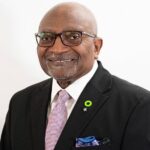
Feb. 9 | Day One kicks off with powerful insights from nationally-acclaimed environmental justice leader Dr. Robert Bullard, founding director of the Bullard Center for Environmental and Climate Justice and distinguished professor of urban planning and environmental policy at Texas Southern University. He'll join us as we explore how we, as funders and partners, are meeting this moment of change — individually and collectively.
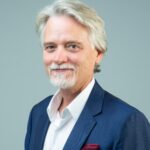
Feb. 10 | Day Two begins with journalist and author Chris Tomlinson, who will unpack the political, social and organizing fabric that shape the south — and therefore, the country.
- We'll then depart for site visits to learn from Houston water advocates, community members and funders about the community-centered resilience work happening in the flood-prone metropolis. We’ll be joined by leaders from Houston Water to share alongside advocates about their collective OneWater efforts.
- The day will close with a lively “Fast Pitch” session, where funders share bold ideas and explore collaborative, fundable projects.

Feb. 11 | Day Three turns our lens outward, focusing on how to support movement-building across an ecosystem of diverse players, coalitions and interests.
- Funders will process the many moving efforts to build power at local and state levels and how these efforts ladder up for bigger, future progress.
- We’ll spend time diving deep into funder-led discussions focused on areas for activation, such as climate migration, data centers, implementation of federal infrastructure funding and the water workforce.
- National water leader Radhika Fox will wrap up our gathering as our final featured speaker, helping us chart a path for foundations, nonprofits and other water stakeholders to meet what lies ahead.
Newcomers are welcome! Join us if you are already engaged with TFN's Urban Water Funders working group — or are looking to learn more about us. Registration is open to donors, staff, directors and trustees of all grantmaking institutions.
Visit the Urban Water Funders 2026 Annual Meeting event page to access our draft agenda and for information on registration and lodging.
California Wellness Foundation CFO: Fund managers from diverse backgrounds are delivering standout returns | Cross post
The Funders Network is committed to sharing the stories and strategies of our members, partners and others in the philanthropic sector working to create more sustainable, prosperous and equitable communities.
Today, we’re lifting up a recent opinion piece in Fortune authored by Rochelle Witharana, Chief Financial and Investment Officer for The California Wellness Foundation, why the foundation aligned its endowment with its mission by ensuring its assets are managed by firms that are led by significantly diverse teams.
By Rochelle Witharana, CFO at The California Wellness Foundation
The next big investing opportunity isn’t buried in the markets – it’s hiding in plain sight. The data keep stacking up: fund managers from diverse backgrounds are delivering standout returns.
The latest report from the National Association of Investment Companies found that managers who are women or from racially diverse backgrounds outperformed private-equity benchmarks with a 16 percent internal rate of return, compared with 9 percent for the median. This kind of return is catching the eye of CalPERS, the California state pension plan with $500 Billion of assets to manage.
And yet the majority of institutional investors continue to ignore the smart money, instead pouring trillions through the same old-school, closed-door networks.
At the California Wellness Foundation, we’ve seen the strength of diverse managers in our own portfolio. Since 2016, we’ve invested through diverse fund managers who bring fresh insight, disciplined execution, and long-term vision. The results speak for themselves: steady, market-rate performance and broader impact for our mission to advance wellness for California’s communities.
Resetting Risk and Reward
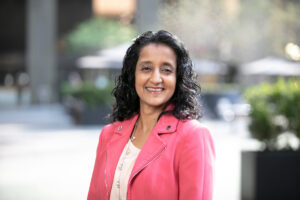
Research from McKinsey, and BCG and Cambridge Associates shows that companies led by women and people of color consistently outperform peers in preparation, strategy, and execution. They invest earlier, identify overlooked opportunities, and back founders serving fast-growing, underserved markets.
With all the performance data you would think that gender and racially diverse managers would be attracting an enormous volume of portfolios to invest. But that’s not happening.
A Knight Foundation survey shows out of $82 trillion of assets under management in the US, just 1.4% were invested with diverse managers in 2021. So where is everyone?
Traditional investing often favors familiarity: established firms, “old boy” networks, and stagnant playbooks. Such narrowness can stifle innovation and overlook emerging value.
Diversifying managers outside of old school networks brings a dimension beyond the expected – that prized edge that delivers higher financial returns. When investors draw from wider experience and networks, they see risk and potential more clearly. They also capitalize on stable, undervalued markets that hold untapped growth potential.
➡️Head to Fortune to read Rochelle's full commentary piece, Fund managers from diverse backgrounds are delivering standout returns and the smart money is slowly starting to pay attention
Partners for Places Jobs and Inclusive Infrastructure Initiative: Six Communities, $1.5 Million in Matching Grants
BY Tere Figueras Negrete, TFN Senior Communications Director
A new grant program will help communities tap the potential of infrastructure projects to drive economic growth where it’s needed most — helping scale small businesses, train and retain skilled workers, and build career pathways for young people in critical industries.
In all, six communities will receive $1.5 million in matching grants through the Partners for Places Jobs and Inclusive Infrastructure Initiative to effectively and equitably implement public infrastructure projects across the U.S., including in rural counties, large urban cities and on Tribal lands.
The six grantee communities are: Albuquerque, N.M.; Atlantic City, N.J.; the Kalispel Reservation near Usk, Wash.; Milwaukee, Wis.; Pittsburgh, Pa.; and Tucson, Ariz.
This new initiative, a program of The Funders Network (TFN), will ensure public infrastructure projects improve communities through job creation, workforce development and training, equitable contracting and other economic benefits.
Local partnerships are at the heart of the Partners for Places Jobs and Inclusive Infrastructure Initiative, which provides funding, technical expertise and other support for grantees as they work to complete infrastructure projects — while keeping the needs of their communities at the forefront.
“Even with recent rollbacks in federal infrastructure funding, there are still billions of public dollars committed to community infrastructure projects across the country,” said Ann Fowler Wallace, Vice President of Programs and Partnerships for The Funders Network. “The Partners for Places Jobs and Inclusive Infrastructure Initiative brings together key partners to make sure these projects are completed in ways that center community values and voices.”
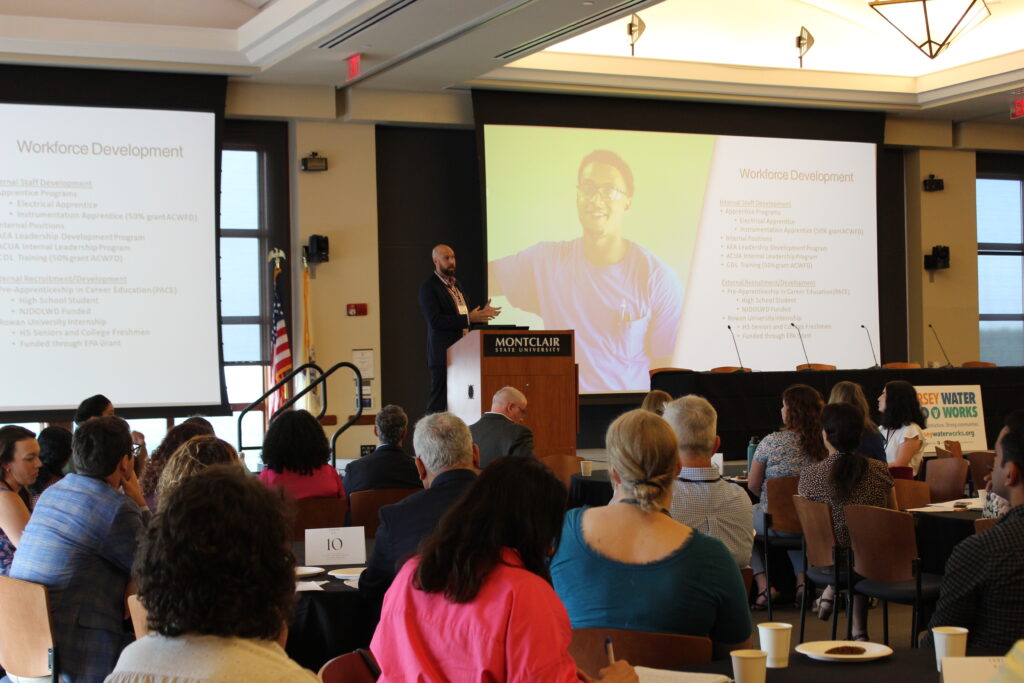
Matthew DeNafo, president of the Atlantic County Utilities Authority, highlights the importance of the water workforce in New Jersey. Atlantic City community partners will use its Partners for Places funding to upskill and retain utility workers essential to sustaining local infrastructure. Photo credit: New Jersey Water Works Collaborative.
How will these six grantee communities use their Partners for Places Jobs and Inclusive Infrastructure Initiative grants?
Community partners in Albuquerque will connect dozens of young people to a forestry project across urban and rural areas in Bernalillo, McKinley, and Doña Ana counties, helping them acquire skills that both create career pathways to high-quality jobs and support climate resilience in their communities.
In Tucson, the funds will help local landscapers and arborists scale their operations and help their workers acquire the certifications needed to secure government contracts, ensuring small business owners benefit from a federally funded urban forestry project.
Four of the grantee communities will focus on investments in water infrastructure and workforce development, creating pipelines for job opportunities and career advancement in a critical industry.
In Milwaukee, where efforts to clean up the Milwaukee Estuary have resulted in one of the largest environmental infrastructure efforts in the country, community partners will connect residents to cleanup jobs, apprenticeships and training.
Pittsburgh, which is tackling the largest water infrastructure modernization project in the city’s history, will use its Partners for Places Jobs and Inclusive Infrastructure Initiative funds to recruit, train and employ new pools of workers to support the project and benefit from new, family-sustaining careers.
“The strength of our infrastructure depends on the strength of our workforce,” said Rob Cherry, CEO of Partner4Work in Pittsburgh. “This investment builds pathways into high-demand careers while supporting critical projects that will keep our region running for decades to come.”
Community partners in Atlantic City, concerned about a looming shortage in the national water labor sector as highly skilled workers retire, will use these funds to train and retain current water utility employees — expanding access to opportunities that will help them grow in their careers and sustain the local water infrastructure.
And on the Kalispel Reservation in Washington, the Kalispel Tribe of Indians is implementing a new, sovereign drinking water system in direct response to a water supply crisis that has plagued their community with boil-water advisories, pressure failures and other issues. Community partners will use the Partners for Places Jobs and Inclusive Infrastructure Initiative funds to create both temporary construction jobs and permanent careers in water utility operation and management.
The first round of this pilot initiative will provide $640,000 to the six grantee communities through the grant program. With contributions from local funders, a total of $1.5 million in funding will be committed to the selected communities.
The Partners for Places Jobs and Inclusive Infrastructure Initiative is supported by the generosity of Spring Point Partners, a social impact organization that is among the more than 110 grantmaking institutions that are members of TFN.
"We are thankful to The Funders Network for having the vision for this work and for the opportunity to support it in its initial stages," said Chetana Mirle, Interim Chief Grants Officer for Spring Point Partners.
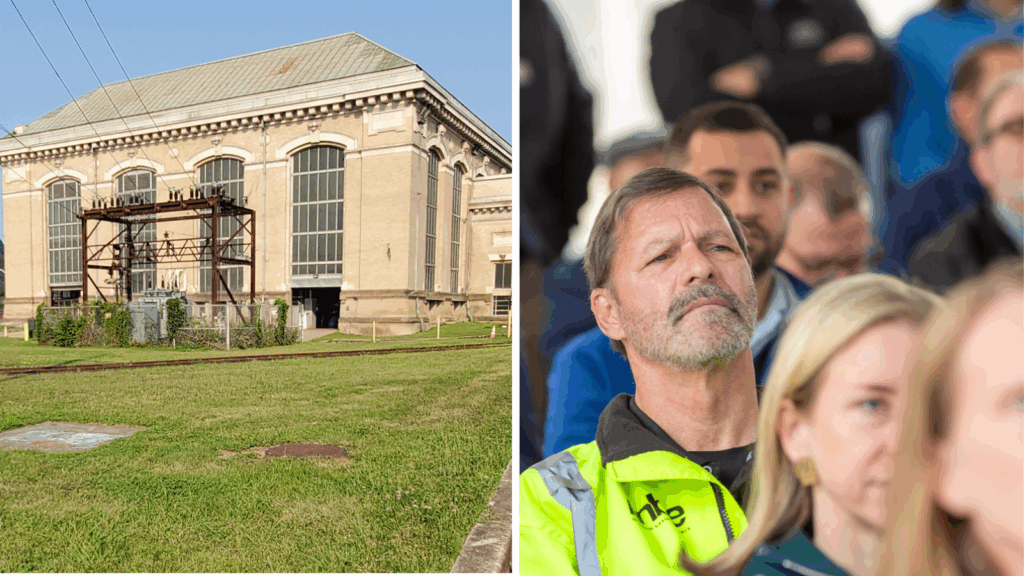
Pittsburgh's plan to modernize and protect the city's drinking water system for generations to come includes a major overhaul of the Aspinwall Pump Station, including preservation of the building’s historic façade and architectural features. Construction and building trade representatives attended a kick-off event for the project in November 2025. Photo credit: Pittsburgh Water.
The Partners for Places Jobs and Inclusive Infrastructure project descriptions, grant recipients, community partners and matching funders are:
- Albuquerque, N.M. ($110,000): To train and place youth in water and climate resilience careers through pre-apprenticeships, apprenticeships, and partnerships with city/county infrastructure projects. Grant recipient: The Semilla Project. Community partners: PowerCorps and Coalitions & Collaboratives, Inc. Matching funder: W.K. Kellogg Foundation ($500,000).
- Atlantic City, N.J. ($90,000): To enhance job skills in the water sector, creating economic opportunities and promoting sustainability in the Atlantic City area. Grant recipient: New Jersey Future. Community partners/ Matching funders: Atlantic County Utilities Authority, Atlantic City Municipal Utilities Authority and Jersey Water Works ($55,000).
- Kalispel Reservation near Usk, Wash. ($110,000): To create pipelines to both temporary construction jobs and permanent careers in water utility operation and management connected to a new sovereign drinking water system for the Kalispel Reservation. Grant recipient: The Kalispel Tribe. Community partner: Kalispel Department of Public Works. Matching funders: Paul Allen Foundation and Innovia Foundation ($25,000).
- Milwaukee, Wis. ($110,000): To ensure Milwaukee’s $500 million investment in waterway restoration delivers equitable opportunity by connecting frontline residents to cleanup jobs, apprenticeships, and training. Grant recipient: Harbor District Inc. Community partners: Milwaukee Metropolitan Sewerage District and Milwaukee AOC Community Advisory Committee. Matching funder: Fund for Lake Michigan ($160,000).
- Pittsburgh, Pa. ($110,000): To expand workforce equity by training underserved frontline communities for family-sustaining careers while supporting Pittsburgh's largest water infrastructure modernization project. Grant recipient: Partner4Work. Community partners: Pittsburgh Water and Sewer Authority, Trade Institute of Pittsburgh, A. Philip Randolph Institute – Pittsburgh and Pittsburgh Gateways. Matching funder: Henry L. Hillman Foundation ($60,000).
- Tucson, Ariz. ($110,000): To scale local landscaping firms and certify frontline workers to secure contracts, bridging workforce training and business readiness to build Tucson’s inclusive green economy. Grant recipient: Local First Arizona Foundation. Community partners: Pascua Yaqui Development Corporation, City of Tucson and Tucson Clean and Beautiful Commission. Matching funders: Freeport-McMoRan Foundation, Arizona Community Foundation and Arizona Complete Health ($60,000).
About The Partners for Places Jobs and Inclusive Infrastructure Initiative
The Partners for Places Jobs and Inclusive Infrastructure Initiative, a project of The Funders Network (TFN), is a matching grant program that helps community partnerships unlock public dollars, increase opportunities for small businesses, and create career pathways for local workers.
These grants support communities that are advancing work on infrastructure projects supported by federal, state or other public dollars. This funding is not for the physical infrastructure itself, but for the human infrastructure needed to create meaningful collaborations and center community engagement.
Through the Partners for Places Jobs and Inclusive Infrastructure Initiative, grantee communities receive investment and technical support to effectively and equitably ensure public infrastructure projects improve frontline and low-wealth communities through job creation, workforce development and training, equitable contracting, and other economic benefits.
This new initiative is part of TFN’s broader Partners for Places community-centered matching grant program, which focuses on projects that foster long-term local relationships that make communities of all sizes more prosperous, livable and vibrant.
To date, the Partners for Places grants program has awarded more than $13 million across North America over the past decade, leading to nearly $26 million in investments.
For additional information and media inquiries, contact: Tere Figueras Negrete, Senior Communications Director at The Funders Network at tere@fundersnetwork.org
Featured image: Matthew DeNafo, president of the Atlantic County Utilities Authority, highlights the importance of the water workforce in New Jersey at a local event. Photo credit: New Jersey Water Works Collaborative..
A Message from our President & CEO: With philanthropy under attack, now is the time to turn values into action — and tap into our shared strength
BY Dion Cartwright, TFN President & CEO
Philanthropy, at its best, is about turning values into action.
Protecting our planet and advocating for justice. Providing services to those most in need and helping communities recover from crises. Uplifting artistic expression, expanding opportunity and nurturing civic participation.
Every day, I witness members of this network practice their values by moving resources toward causes of critical importance.
This work is not easy. It takes collaboration, compassion and conviction.
So when I read the news about the recent presidential memorandum that unfairly casts suspicion and increased scrutiny on charitable foundations, philanthropic networks and nonprofits — institutions rooted in service, generosity and stewardship — I was both deeply concerned and deeply offended.
But definitely not surprised.
We’ve known for some time that the philanthropic sector could be targeted by an administration that has already launched a barrage of executive orders, investigations and public insults against universities, law firms and other institutions meant to instill fear and quiet dissent.
Even though the recent headlines may have confirmed what many of us suspected was coming, it brings additional stress and strain as we navigate the impacts on our organizations, grantee partners and the communities we serve.
And less time focused on the values that moved us to action in the first place.
Maybe you were inspired by your faith tradition to see a higher purpose in serving others.
Maybe you were motivated by stories of civil rights icons or labor leaders or climate activists.
Or maybe you just had a grandma who never let a hungry stranger pass by her door without offering them something to eat.
We may have arrived at this work from different places, and for different reasons. But the members of The Funders Network share a common commitment to helping create communities that are more resilient, sustainable, healthy and prosperous.
This is work that strengthens our democracy, not weakens it.
No politician, regardless of party, should be able to tell you how to direct your grantmaking or target your team because they disagree with your organization’s mission or values.
Attack on Fundamental Freedoms
The recent directive, which expands federal oversight of nonprofits and philanthropic organizations, is framed as part of a broader effort to address domestic terrorism and political violence.
But this is really an overt attempt to silence our freedom of speech and freedom to give in ways that align with our values.
Foundations and nonprofits must continue to have the freedom to direct their resources as they see fit, regardless of politics or who is in power. And no one should fear for their safety simply for expressing their views, including through peaceful protest.
We at TFN unequivocally condemn the administration’s attempts to restrict these fundamental freedoms, and we strongly object to attempts to cynically mischaracterize the critical work done by foundations and nonprofits.
We recently joined with more than 180 philanthropic institutions in condemning acts of political violence — as well as recent attacks on members of the charitable and nonprofit sector that seek to portray them as contributing to those acts of violence.
The open letter, issued by a coalition of charitable foundations and published by Unite in Advance, was spearheaded and signed by numerous organizational members of TFN.
This is just one of many examples of how our members and others in the sector are choosing to meet this moment.
Tap into TFN
Now, more than ever, we must lean into the collective wisdom, experience and strength of this network.
Across TFN, there are rich resources to draw from, including learning cohorts, working groups and peer communities that are bringing funders together.
They’re engaging in deep-dive conversations, learning sessions and one-on-one calls to untangle complex issues, share strategies and identify opportunities for collaboration and action.
There is a deep reserve of hard-earned wisdom in our ranks.
Just last week, I was on a peer community call with members who have been effectively navigating tough political climates and policies at the state and local levels for years. They gave fellow funders not only practical advice about how to face our current challenges, but also a sense of empowerment and resolve by sharing specific examples, tools and successes.
We all have something to share, and we all have something to learn.
That’s why I encourage you to deepen your engagement with TFN in this difficult moment.
Together, we can stand firm in our values, strengthen our collective impact and ensure that philanthropy continues to be a force for resilience, justice and transformation in our communities.
If you’re new to TFN, unsure how to connect with others in our network, or would like to set up a candid one-on-one call with a member of our leadership team, please don’t hesitate to reach out to us at membership@fundersnetwork.org.
We’re here to help, and we would love to hear from you.
Thank you for your ongoing support of our network, and of each other.
Additional Resources
Statement on Political Violence and the Fundamental Freedom of Speech | Unite in Advance
Statement: Government Actions Threaten the Independence of the Philanthropic Ecosystem | United Philanthropy Forum
Increased Compliance and Risk Measures for Philanthropy Organizations
The United Philanthropy Forum has shared these key takeaways and action steps following the recent executive memorandum. (TFN is a member of the Forum.)
Key Provisions Affecting Philanthropy:
- The IRS, DOJ and Treasury have been directed to increase monitoring of tax-exempt organizations for potential involvement — direct or indirect — in activities linked to domestic terrorism or organized political violence.
- Nonprofits, funders, boards and employees may be investigated if suspected of providing support or coordinating with such entities domestically or internationally.
- Agencies are expected to review existing and prospective grants, partnerships and programs for compliance, with a focus on preventing illicit funding or association with groups designated as involved in criminal activity or terrorism.
- While the memorandum does not itself create new compliance rules, it signals a shift toward heightened oversight and enforcement.
Potential Action Steps for Foundations:
- Review current risk and compliance practices related to grantmaking, partnerships and political activities.
- Update internal policies and procedures to anticipate strengthened federal oversight.
- Increase training and guidance for foundation staff and boards on compliance and transparency.
For additional advice on compliance and risk measures for foundations, visit the United Philanthropy Forum's Executive Actions Impacting the Philanthropic and Nonprofit Sectors.
About the Author
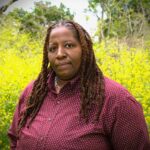
Dion Cartwright is the president and CEO of The Funders Network, Dion first joined TFN in 2016 to direct the PLACES Fellowship program and lead the organization’s work to address equity, inclusion, and structural racism. Visit our team page to learn more about Dion and the rest of our staff at TFN.
Statement on Political Violence and the Fundamental Freedom of Speech: TFN joins more than 100 philanthropic organizations in open letter published by Unite in Advance
BY TFN Staff
The Funders Network has joined more than 100 philanthropic institutions in condemning acts of political violence — as well as recent attacks on members of the charitable and nonprofit sector that seek to portray them as contributing to those acts of violence.
The open letter issued by a coalition of charitable foundations, including numerous members of TFN, was published Wednesday by Unite in Advance.
"Organizations should not be attacked for carrying out their missions or expressing their values in support of the communities they serve. We reject attempts to exploit political violence to mischaracterize our good work or restrict our fundamental freedoms, like freedom of speech and the freedom to give," reads the statement.
"Attempts to silence speech, criminalize opposing viewpoints, and misrepresent and limit charitable giving undermine our democracy and harm all Americans."
TFN stands in solidarity with our members and others in the sector committed to creating communities that are more prosperous, sustainable and just, and rejects divisive efforts to impede this critical work.
We've shared the full statement below.
➡️ To read the letter along with the full list of signatories, visit the Unite in Advance post on Medium here.
Additional Resources
➡️ In the news: 100-Plus Foundations Stand United as White House Goes on the Attack by the Chronicle of Philanthropy's Alex Daniels.
➡️ About Unite In Advance: Read this Nonprofit Quarterly piece by Tonya Allen of the McKnight Foundation, Deepak Bhargava of the Freedom Together Foundation, and John Palfrey of the MacArthur Foundation.
Statement on Political Violence and the Fundamental Freedom of Speech
Published by Unite in Advance
“Acts of political violence — from the recent murder of Charlie Kirk to the murder of Speaker Emeritus Melissa Hortman of Minnesota — have no place in our democracy. Our hearts are with the families and loved ones of those lost to these senseless attacks, and we extend our deepest sympathy in the face of unimaginable pain.
Our country is built on the premise that everyone has the right to express themselves, even when others don’t agree with or like what they say. No one should fear for their safety simply for expressing their views. We must all forcefully condemn these heinous acts as affronts to the fundamental principles and health of our nation — and as charitable giving organizations, including those working in communities impacted by these tragedies, we do.
Our organizations are composed of people working to strengthen communities. We support our neighbors when they are in need and remain committed to uniting across divides and partisanship. Philanthropy exists to bring people together, not drive them apart.
Organizations should not be attacked for carrying out their missions or expressing their values in support of the communities they serve. We reject attempts to exploit political violence to mischaracterize our good work or restrict our fundamental freedoms, like freedom of speech and the freedom to give. Attempts to silence speech, criminalize opposing viewpoints, and misrepresent and limit charitable giving undermine our democracy and harm all Americans.
At a moment that is fragile and fraught, we must rise to the higher standard we all collectively desire. Now is a moment for leadership that drives unity rather than sows further division. Our organizations will continue focusing on helping people across all backgrounds, geographies, ideologies, and belief systems, to heal, thrive, and live peacefully together, protected by the freedoms guaranteed in our Constitution."
"Amuurica!" by Katherine Albin is licensed under CC BY-ND
New Funding Opportunity: Partners for Places Jobs and Inclusive Infrastructure Initiative
BY TFN Staff
The Funders Network is launching a new pilot funding opportunity that will leverage infrastructure funds to ensure projects benefit underserved areas, including training and expanding career pathways for local workers in critical industries.
The deadline to apply is Sept. 15, 2025
The Partners for Places Jobs and Inclusive Infrastructure Initiative is aimed at supporting communities with investments and technical expertise to effectively implement equitable infrastructure projects. This new pilot will be launched through the Partners for Places community-centered grantmaking program.
With this initiative, Partners for Places will award place-based grants to community partnerships advancing inclusive infrastructure projects, support cohort learning, and provide access to regional and national expertise to help communities achieve their goals.
This funding is not for the physical infrastructure itself, but for the human infrastructure needed to create meaningful collaborations and center community engagement.
This value is at the heart of Partners for Places: bringing together the key partners who can make tangible progress on shared goals while keeping the voices of communities front and center.
The focus of this new initiative is to enable communities to ensure that project implementation directly benefits frontline and low-wealth communities through job creation, workforce development and training, equitable contracting, and other inclusive economic modalities.
The grant is intended for projects that are already supported by public funds. These include water infrastructure funds, as well as Inflation Reduction Act (IRA) and Bipartisan Infrastructure Law (BIL) funds that have already been allocated.
The first round of investments will have a strong emphasis on place-based water-related projects. TFN anticipates at least half of the projects will focus on water project implementation. Those working in other infrastructure areas may apply.
Partners for Places Jobs and Inclusive Infrastructure Initiative
Resources:
- Application Information and Forms
- Click here to access the Invitation to Apply, Selection Criteria and other documents.
- Overview Session: July 30 from 2-3 p.m. ET
-
- TFN will provide more information about this pilot funding opportunity during this virtual overview session.
-
Questions?
- For questions about this funding opportunity, please reach out to TFN’s Vice President of Programs and Strategic Partnerships Ann Fowler Wallace at ann@fundersnetwork.org
- For funders interested in investing in the Partners for Places Jobs and Inclusive Infrastructure Initiative, or the core Partners for Places grant program, reach out to TFN’s Chief Development Officer Aileen Rosa Sánchez at aileen@fundersnetwork.org.
Featured image: Members of TFN’s Urban Water Funders and Inclusive Economies working groups gathered in Baltimore to discuss the new Partners for Places funding initiative following TFN’s 25th Anniversary Conference in March.
Going PLACES: From NYC to CNY, a Journey of Equity, History & Belonging
BY Jonathan T. Reid, Program Officer, ECMC Foundation, and 2025 PLACES Fellow
As a native New Yorker, I thought I knew my state. But until recently, I had never set foot in Syracuse. That changed during a site visit with my TFN PLACES Fellowship cohort — and what I found there felt like a homecoming.
TFN's PLACES (Professionals Learning About Community, Equity and Sustainability) Fellowship is more than a professional development program. It’s a journey into the heart of place-based philanthropy, equity-centered leadership, and systems change. Through immersive site visits, fellows explore how philanthropy can be a tool for justice, not just charity. We learn to ask deeper questions, challenge assumptions, and center community voices in our work.
Syracuse is a small(ish) city with big-city challenges and an even bigger heart. We were welcomed by the Central New York Community Foundation, whose commitment to equity is not just in their mission — it’s in their methods. Their trust-based, community-led approach to grantmaking is a model for how philanthropy can shift power, not just resources. They fund local organizations doing the work, not just those with the right connections. That distinction matters.
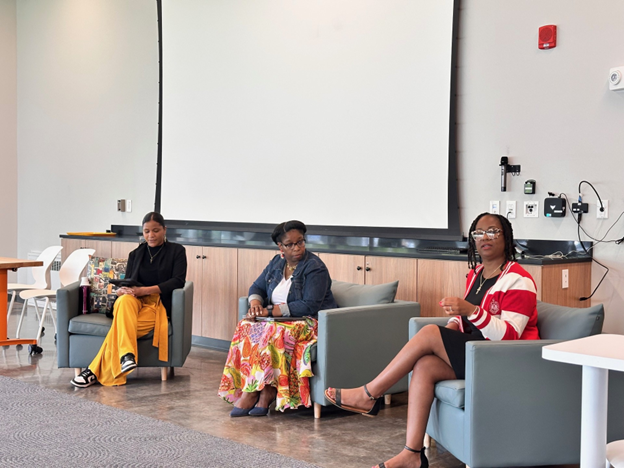
The PLACES 2025 Cohort's site visit to Syracuse included a conversation with Black maternal health experts. From left: Rachel Johnson, Keturah Albright and Tiffany Lloyd.
One of the most inspiring stops was the Asha Laaya Farm (Farm of Hope), the agricultural branch of Deaf New American Advocacy Inc. Seeing how they are cultivating both food and community was deeply moving. Their work is a reminder that equity includes language, culture and access to land. It’s about creating accessible spaces where everyone can thrive.
We also visited the Community Folk Art Center, a vibrant hub for Black and Brown artists and cultural expression. There, and throughout our visit, we were reminded that art is not just decoration — it’s resistance, storytelling, and healing.
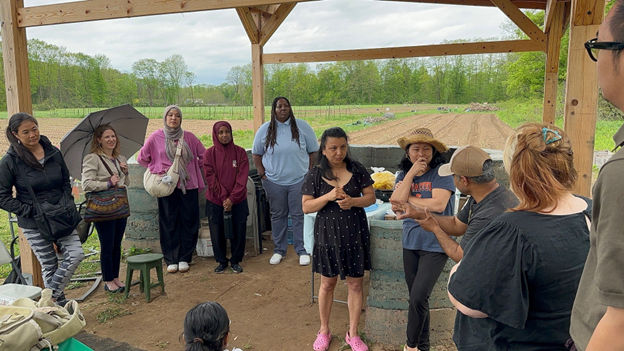
PLACES 2025 Fellows visited with the leaders of Asha Laaya Farm (Farm of Hope), a branch of Deaf New American Advocacy.
Our time with Robert Searing, education director at the Onondaga Historical Association, grounded us in the city’s complex history. From the legacy of Harriet Tubman to the Jerry Rescue, Syracuse has long been a site of resistance and refuge. These stories are not just historical footnotes — they echo the city’s present-day struggles and triumphs. The same spirit that fueled the Underground Railroad now fuels community-led efforts to address housing, education and economic justice.
Philanthropy has a role to play in this. But it must be the right role. Too often, we fund organizations based on relationships, not results. In a “word of mouth” city like Syracuse, that can reinforce inequities. We need to fund the work — not just the people we know. That means asking hard questions, having real conversations, and, as one of our speakers reminded us, learning to “ask ‘why’ five times” to get to the root cause. Surface-level solutions won’t cut it.
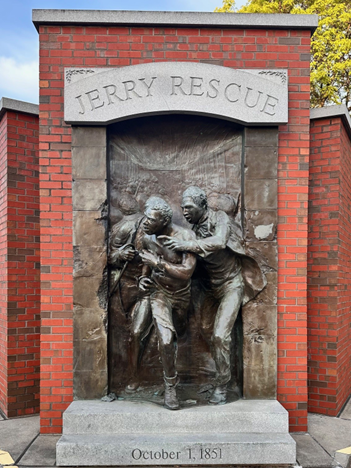
A monument to the "Jerry Rescue" in Clinton Square, Syracuse. In 1851, a crowd of abolitionists in Syracuse rose to the defense of a fugitive from slavery named William Henry, also known as "Jerry," who had been arrested under the Fugitive Slave Act of 1850. Jerry's arrest was met with fierce resistance from the local abolitionist community, who forcibly freed him from his captors and helped him escape to Canada.
What stood out most during our visit was the presence of what I’d call “unconditional solidarity.” It’s more than allyship — it’s a deep, ongoing commitment to standing with communities, not just for them. The organizations we met are doing the hard work of shifting power back into the hands of the people. That’s not easy. Connecting community-based organizations with systems is complex and often messy. But it starts with trust.
And trust was everywhere. I felt it in the way we were welcomed. I saw it in the relationships between funders and grantees. I heard it in the stories shared over meals and meetings. Syracuse may be new to me, but it felt like home because of the people who opened their doors and hearts to us.
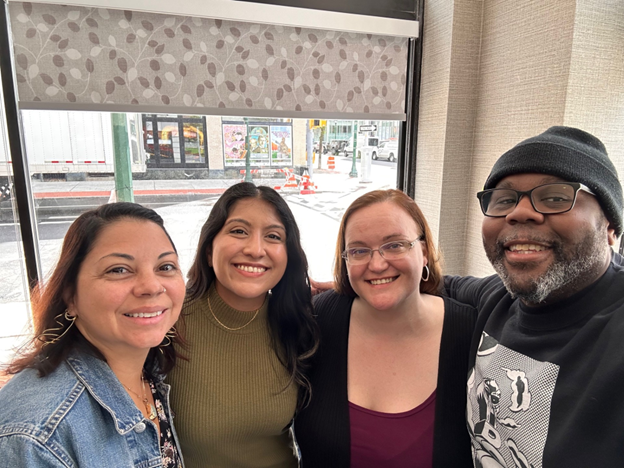
PLACES 2025 Fellows during the site visit to Syracuse. From left: Raquela Delgado Valentin, Leticia Rojas, Brandy Cramer and Jonathan T. Reid.
This visit reminded me that equity work is not about parachuting in with solutions. It’s about showing up, listening deeply, and staying in the conversation. It’s about recognizing the unequal distribution of power — and doing something about it.
As I return to my own community and work back at ECMC Foundation, I carry Syracuse with me. Its history, its people and its lessons. I’m grateful to TFN’s PLACES Fellowship for creating the space to learn, reflect and grow.
And I’m even more grateful to the people of Syracuse for showing us what it looks like to live your values out loud.
About the Author
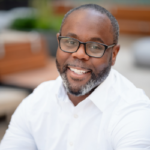
Jonathan T. Reid is a program officer at ECMC Foundation. He oversees a portfolio of grants focused on increasing the number of college students from historically underrepresented backgrounds, including low-income and first-generation populations, who pursue and attain postsecondary credentials. He is also a member of TFN's 2025 PLACES Cohort.
Photo credits: All photos courtesy of Jonathan T. Reid.
Statements of Solidarity & Resources for the Sector
BY TFN Staff
TFN originally shared this statement on June 10, 2025, in solidarity with those peacefully protesting ICE raids and militarization of our communities in L.A. and elsewhere. Below is a round-up of solidarity statements and resources from TFN members and others in the sector. To add your organization's statement or resources to this list, please reach out to Brooke McPherson at brooke@fundersnetwork.org
The California Wellness Foundation
Sierra Health Foundation and The Center
Joint statement from California for Prosperity and Affordability
Additional Resources:
Grantmakers Concerned with Immigrants and Refugees’ 100 Days In: A Roadmap for Funding Migrant Justice captures the philanthropic and movement efforts in support of immigrant and refugee communities that have sprung up across the country.
Liberty Hill Foundation's Immigrant Rights and Protections Docket: Defending Immigrant Rights, Supporting Families, and Advancing Justice
San Francisco Foundation | Spring 2025 Give Guide
San Francisco Foundation | Give Guide: Protect Immigrants and Refugees
TFN Statement: In solidarity with those defending immigrant communities & fundamental human rights
BY TFN Staff
TFN originally shared this statement on June 10, 2025. Please read our companion blog post for a round-up of solidarity statements and resources from TFN members and others in the sector.
The Funders Network stands in solidarity with those in California and elsewhere who are organizing, resisting and mobilizing in defense of immigrant communities and fundamental human rights.
What has unfolded in recent days across Los Angeles is both heartbreaking and deeply alarming.
This is not about politics or policy debates. This is about dignity, safety and the right to live free from fear.
The xenophobic and aggressive tactics we are witnessing represent a dangerous escalation that inflicts lasting trauma, destroys trust, and tears families and communities apart.
The Funders Network, including our Smart Growth California initiative, remains committed to supporting movements for justice, equity and belonging.
Partners for Places: Meet the New Grantees!
BY Tere Figueras Negrete, TFN Senior Communications Director
A local gardening club will lend their decades of expertise to help install rain gardens in a flood-prone neighborhood.
Citizen scientists will be empowered to help keep groundwater safe for drinking.
And low-income families will get welcome upgrades like plug-in air conditioners and electric appliances that will make their homes more livable and climate resilient while reducing their energy costs.
These are just a few of the sustainability projects supported by the latest round of Partners for Places grants, which help fund efforts to create more equitable and resilient communities across the U.S.
In all, seven U.S. communities will receive nearly $1.6 million in Partners for Places matching grants that bring together local governments, place-based funders and frontline community groups — fostering collaborative relationships, building trust and driving meaningful impact.
Successful Partners for Places projects advance much-needed climate planning and sustainable solutions in communities both large and small, and across diverse political and geographic landscapes.
Meet the Grantees
The seven communities receiving this latest round of Partners for Places grants are: Binghamton, N.Y.; Burlington City, N.J.; Chicago, Ill.; Denver, Col.; Detroit, Mich.; Memphis, Tenn.; and Orlando, Fla.
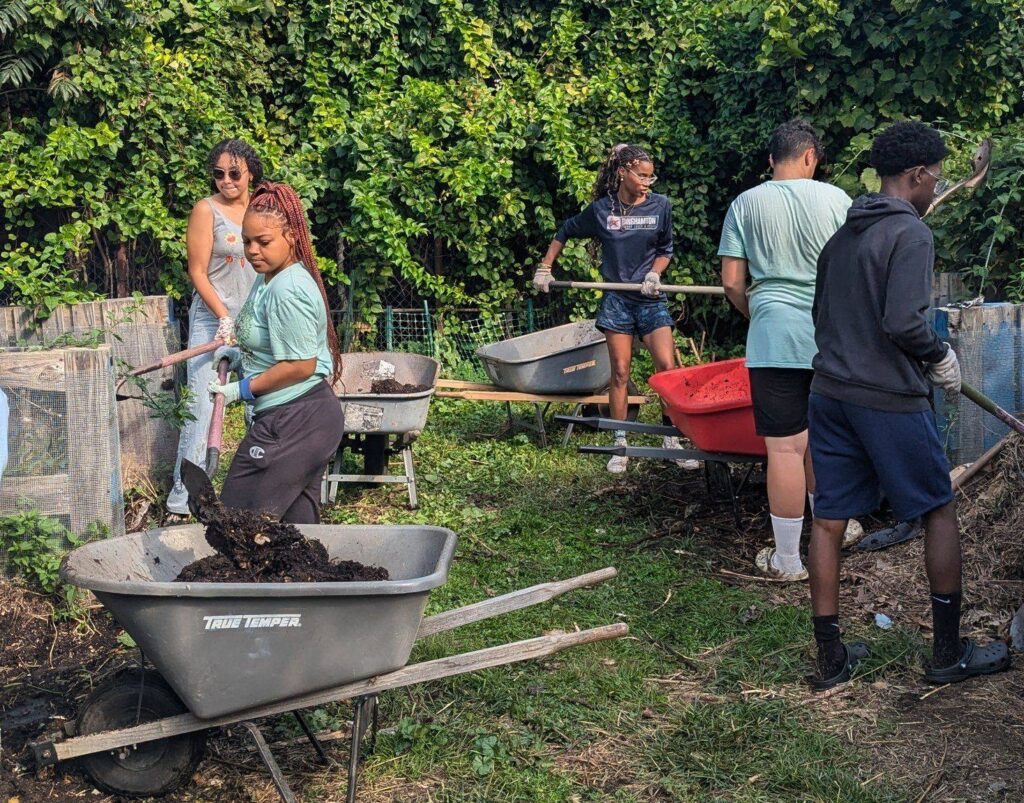
Partners for Places will help support a community-led composting program in Binghamton, N.Y., that provides nutrient-rich fertilizer for neighborhood food gardens and diverts waste from landfills. Photo credit: Volunteers Improving Neighborhood Environments (VINES).
How will these Partners for Places grants help local sustainability efforts?
In Binghamton, Partners for Places will help create a community composting program that diverts food waste from landfills, reduces greenhouse gas emissions, and generates nutrient-rich fertilizer for local food gardens. The program will help neighbors start composting in their own backyards, train volunteers and youth employees to maintain upgraded composting systems in community gardens and set up a composting facility at an urban farm that will eventually process up to 1,000 pounds of food scraps per week.
Orlando will use its Partners for Places grant to help low-income renters, most of whom have recently been homeless or are at risk of homelessness, reduce their utility bills and increase resilience in a state known for its hurricanes, heat and other extreme weather events. The project includes installing energy-efficient “plug in” appliances like window air conditioners and placing portable solar units on rooftops, balconies or yards with battery back-ups that can power lifesaving medical equipment during an outage. Residents also receive an energy efficiency basket containing educational materials, LED lights, aerators and glow-in-the-dark star stickers — intended to encourage kids to turn off lights to see their stars shine.
Denver will also use Partners for Places funds to help low-income residents make their homes more climate resilient and energy efficient while working to improve indoor air quality in the Globeville and Elyria-Swansea neighborhoods — which are often regarded as some of the most polluted neighborhoods in the nation. This includes reducing pollution through electrification of homes, weatherization, and advancing clean energy solutions. The project will also create a shared governance model to oversee the grant and spark collective action around shared priorities like emergency preparedness.
Ashley Perez, energy policy coordinator with the City of Orlando, carries one of the energy efficiency baskets that will be distributed to low-income households with the support of Partners for Places funds. Photo credit: City of Orlando.
With the support of matching local funders, these projects also help build bridges between city officials and the communities that bear the brunt of environmental injustice but are often left out of decision-making processes.
In Memphis, the grant will be used to train and empower “citizen scientists” and other residents of the Alcy Ball neighborhood to create a community-driven groundwater protection plan. The South Memphis neighborhood is centered on the site of a defunct World War II defense depot where everything from carcinogenic industrial liquids to Nazi mustard gas bombs were buried – directly above a critical aquifer. A massive breach in the confining clay layer protecting the aquifer renders South Memphis’ drinking water particularly vulnerable to contaminants in the ground above. The project includes mapping aquifer vulnerabilities, resident-led environmental testing, and outlining a community-driven plan for aquifer protection and green infrastructure interventions.
In Chicago, decades of disinvestment in the city’s South and West Sides have left residents vulnerable to heightened flooding and sewage issues, depleting community resources and eroding trust in local leadership. Partners for Places funds will be used to support a community-informed framework for identifying and addressing flooding and sewage disparities, including opportunities for residents to co-create a vulnerability assessment and develop recommendations to the city that will help shift infrastructure investments to these marginalized and climate-vulnerable communities.
This latest round of Partners for Places grants includes two projects specifically designed to advance green stormwater infrastructure, which uses nature-based solutions to manage and treat runoff, reduce pollution, and potentially recharge groundwater.
Burlington City will use the funds to plant shade trees and install rain gardens — sunken landscaped areas that capture rainwater and runoff from hard surfaces like streets — to improve air quality and better capture and cleanse stormwater in a community at risk of flooding due to its proximity to the Delaware River. The plan includes education and training opportunities for residents, as well as activating community volunteers like a local club of veteran gardeners who will lend their expertise to the effort.
Detroit will use Partners for Places funds to build green stormwater infrastructure projects following extensive community input. In a city that has grappled with an aging water infrastructure and frequent flood risks, the project will create a collaborative private-public partnership aimed at fostering community trust, reducing bureaucratic barriers, and developing more sustainable responses to storms and other extreme weather events.
➡️Curious to learn more about green stormwater infrastructure projects? Check out this this fact sheet and video from We the People of Detroit, the community-led group that is partnering with the City of Detroit for their Partners for Places project, about how they transformed an outdoor space into a hub for learning, celebration and environmental stewardship.
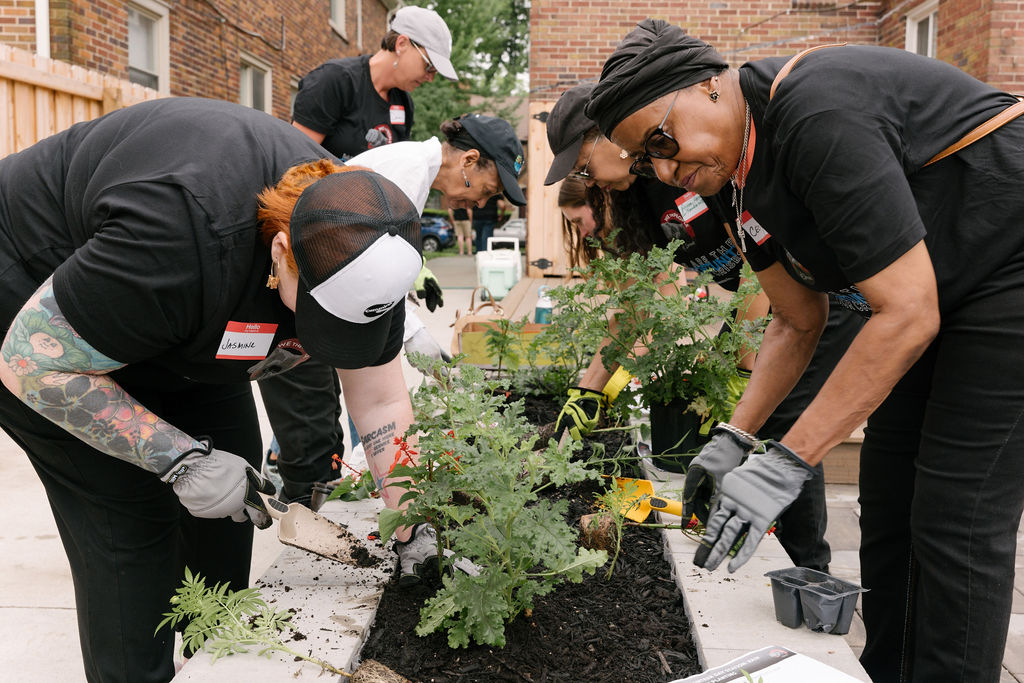
We the People of Detroit will partner with the City of Detroit to advance green stormwater infrastructure solutions in flood-prone areas. Photo credit: Carolina Gutman
Partners for Places, led by The Funders Network (TFN) in partnership with the Urban Sustainability Directors Network (USDN), will provide $925,000 in funding to these seven communities through the grant program. With contributions from local matching funders, a total of $1,557,500 will be committed to fund sustainability projects in these selected communities.
To date, Partners for Places has awarded more than $12 million across North America in this successful matching grant program, leading to more than $25 million in investments.
The matching grant program brings national funder investors together with place-based funders to support equitable, sustainable climate action and green stormwater infrastructure projects. The program’s national investors currently include the Freedom Together Foundation, The Kresge Foundation, and the Pisces Foundation. One or more local foundations are required to provide at least a 50% matching grant.
The latest Partners for Places grant recipients, project descriptions, frontline community groups and matching funders are:
- Binghamton, N.Y. ($115,000): To create a community composting program that reduces waste, lowers emissions, enriches urban agriculture efforts, and engages residents through education and outreach. Frontline community groups: Volunteers Improving Neighborhood Environments, Inc. and Cornell Cooperative Extension of Broome County. Matching local funder: Conrad and Virginia Klee Foundation ($100,000).
- Burlington City, N.J. ($120,000): To support Greening Burlington City, a plan to empower community members with the resources and tools to apply green stormwater infrastructure to improve health and environmental concerns. Frontline community group: The Opportunity League. Matching local funder: Anonymous ($120,000).
- Chicago, Ill. ($150,000): To co-develop a flood and sewage vulnerability assessment and policy recommendations that will help shift infrastructure investments to vulnerable communities impacted by historic disinvestment and facing climate risks. Frontline community groups: Little Village Environmental Justice Organization, Center for Neighborhood Technology, and Alliance for Great Lakes. Matching local funder: Walder Foundation ($150,000).
- Denver, Col. ($125,000): To organize with community partners to improve indoor air quality and address extreme heat for Tierra Colectiva CLT homes and build community governance and resilience. Frontline community group: GES Coalition. Matching local funder: The Denver Foundation ($62,500).
- Detroit, Mich. ($150,000): To create a public-private partnership to advance green stormwater infrastructure (GSI) solutions a more sustainable approach to addressing flooding issues across the City of Detroit. Frontline community group: We the People of Detroit. Matching local funder: Cummins ($75,000).
- Memphis, Tenn. ($150,000): To pilot a community-driven groundwater protection plan in Alcy Ball, implementing green infrastructure and citizen science to protect the local aquifer and create a scalable model for the city. Frontline community groups: Protect Our Aquifer and Alcy Ball Development Corporation. Matching local funder: Hyde Family Foundation ($75,000).
- Orlando, Fl. ($115,000): To bring clean energy, energy storage and energy efficiency upgrades to those who are struggling with their energy bills and are most impacted by climate change. Frontline community groups: Homeless Services Network of Central Florida, Grassroots Impact, and The Desire Foundation. Matching local funders: Central Florida Foundation, and Allegany Franciscan Ministries ($50,000).
Partners for Places FAQs
→ Where is Partners for Places making an impact? Read previous grant announcements and explore the Partners for Places Grantee Map here.
→ Where can I learn about completed Partners for Places projects? Visit the Partners for Places Idea Bank to explore what grantees are doing, learning and sharing.
For additional information and media inquiries, contact: Tere Figueras Negrete, Senior Communications Director at The Funders Network, tere@fundersnetwork.org.
*Feature image at top: We the People of Detroit | Photo credit: Carolina Gutman

